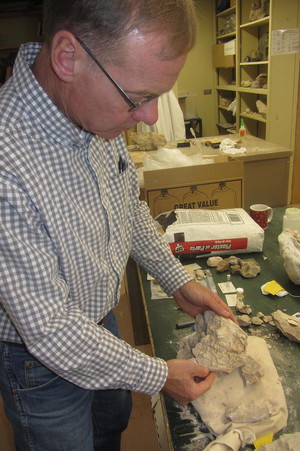On-campus finds add to CSC's rich fossil collection

CHADRON – Students at Chadron State College who have an interest in paleontology don’t have far to go to experience the excitement of finding traces of the creatures that lived on Earth some 40 million years ago because there are fossils right outside the classroom doors.
And the discoveries that students make as part of their classes in that branch of geoscience are adding to the rich collection that has been part of CSC since Eleanor Barbour Cook established the college’s geology department in 1924, according to faculty member Dr. Mike Leite.
Cook was the daughter of Erwin H. Barbour, who was chair of the geology department at the University of Nebraska and director of the state museum, and the wife of paleontologist Harold J. Cook.
“She started bringing in (fossil and mineral) specimens as soon as she moved here” Leite said. “A lot of the specimens she put in the collection.”
Over the years, CSC faculty members have added to the collection that Cook assembled, which is named in her honor and was once housed in the basement of Crites Hall.
Initially, rock and mineral specimens were the most important part of the Cook collection but the emphasis has changed to vertebrate fossils, primarily from the Oligocene epoch, a period between about 40 million and 20 million years ago. In part, that is because much of Nebraska, along with adjoining portions of Wyoming and South Dakota is the best place in North America, and maybe in the world, for finding vertebrate fossils, Leite said.
During the Oligocene period, the region was hot and humid, and inhabited by far different animals than today.
“We had alligators in Nebraska in the early Oligocene,” said Leite, “It was pretty humid and probably forested. It was a warmer world at that time.”
Oreodonts, a small sheep-like creature, were among the area’s inhabitants in those long ago times, and the Cook collection has many oreodont fossils, including some that were discovered and excavated from the gullies and ravines of C-Hill by Chadron State students.
Leite said he wasn’t aware that Oligocene fossils could be found on C-Hill when he started teaching at CSC 20 years ago, although the existence of fossils on college grounds had been reported in a 1960s survey by a noted paleontologist.
“Nobody told me that,” he said.
The Cook collection also didn’t include any specimens collected from campus.
However, in the early 2000s a paleontology student, Ed Welsh of Winnebago, Nebraska, and his roommate, Kyle Cooper, of Rapid City, South Dakota, used their free time to wander around C-Hill, and began finding fossils.
“They were really excited when they brought them in to me,” he said. “We went out and did some exploration. They found hundreds of fossils up there.”
Now Leite regularly takes classes onto C-Hill, and gives students the hands-on experience of paleontology field work. Students have found whole skulls, vertebrae and leg bones of oreodonts, as well as fossils of other animals. It gives them a thrill, Leite mentioned.
“The students get really excited.” he said. “No matter how many they find, they are as excited as the first one.”
After recovering a fossil, it is taken to the collection room where students try to identify the animal it came from. The identification process takes time and involves careful measurements and comparison with specimens in the CSC collection and published data from other institutions.
The entire process is valuable training for students, even if they don’t intend to pursue a career in paleontology, according to Leite.
“As an undergraduate you are getting involved in some kind of research,” he said. “You have the experience of a paleontologist. You got excited about something and collected data. That’s science.”
The opportunity for students to do paleontology field work right on campus may be unique to Chadron State College, according to Leite.
“I couldn’t name another college that has vertebrate fossils on campus,” he said. “It’s not just fossils. It’s geology too. We have incredible canyons to explore. We have faults, we have unconformities and all kinds of geological phenomena out there. It’s right out the door.”
Fossils, rocks and minerals are just part of CSC’s rich natural history collection, Leite noted. There are bird specimens, some of which are probably irreplaceable because of restrictions on collecting wildlife, and an extensive plant and herb collection that is expanding under the direction of faculty member Steve Rolfsmeier, he said.
Many of the most interesting items in the CSC collections are on display in different rooms in the Math and Science Building, but Leite said a planned upgrade of the building is expected to include new exhibit space that will improve the displays. He is also working on a searchable database of the fossil and mineral specimens that can be put online so other researchers can make use of them.
“It’s a valuable research collection and people do come from other places to see this stuff,” Leite said. “The natural history collection here is a big deal and people don’t know it.”
Category: Campus News, Physical and Life Sciences



